
The origins of the Mesoamerican feathered snake god aren’t certain, but the Aztecs believed he came down from heaven twice a year to bring fertility and harvest.
This god of life and of corn, Quetzalcoatl, also appears as a tall, blonde, bearded man. As the feathered serpent, the god represents both spirit and earth, and adorns many pyramids used to offer human sacrifice.

The Aztecs believed in a second coming of Quetzalcoatl. King Montezuma II believed Hernán Cortés was this god when the Spanish conquistador arrived in 1519.
“Through this mythology, Cortés manages to enter the Aztec capitol peacefully,” said José Alfredo Martinez, a guide with Destination Management Services of Mexico. Cortés enlisted the help of other tribes, too, who could have only entered the Aztec city if they were thought to accompany a god.
“If it were not for this, it would have taken 30-40 years to overtake the Aztecs,” Martinez said. Cortés arrived with a mere 500 mounted soldiers. And while they were armed, they would have been no match for the Aztecs.
The indigenous maintained devotion to Quetzalcoatl throughout the land now known as Mexico. That included places like Tula, Chichen Itza and Cholula, where major pyramids were built.
It’s generally said that there are 365 churches built in Cholula — one atop each pre-Hispanic temple. There are actually more like 200 churches, if chapels are included.

In one of them — on Tuesday morning, Jan. 31 — parishioners sat around a chandelier polishing the brass and shining the crystal. They were all volunteers. They give of their time to beautify the Church of San Francisco de Acatepec, which has served their community for centuries.
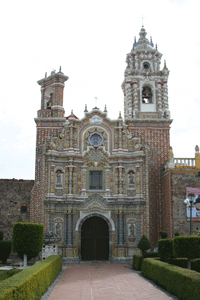
The outside is decked with talavera, a ceramic tile from the state of Puebla.
“Religion is part of everyday life,” said Fr. Ernesto Reynoso, adjutant judicial vicar for the Phoenix Diocese, who was born in Mexico. “Many in today’s society want to remove religion. Thanks be to God, others are keeping religiosity alive.”
In the center of every major city in Mexico, you’ll find a cathedral overlooking the main plaza. It’s there, right next to the restaurants and the bars and the chocolate shops. Municipal buildings are in the cathedral’s shadow.
In Oaxaca, old couples, married for decades, dance traditional dances right next to the Cathedral of the Assumption. In Puebla, artwork is displayed in front of the Cathedral of the Immaculate Conception.
The churches are beautiful because the house of God should be beautiful. Inside and out of the churches, the people trust the God they make a part of their celebrations and their mourning.
“It’s part of our nature not to worry,” Fr. Reynoso said. “We rely on God’s will and Divine Providence. The people believe that. That’s why they feed you and welcome you and you’re part of their family as a guest.”
Tourists from all over the world say this at the end of pilgrimages, said Martinez of DMS. “What they enjoy the most — more than the ruins or the museums or the beaches — is the warmth of the Mexican people,” he said.
The people are welcoming despite a history of invasion. It began with the Spanish conquest and continued with incursions by the United States and France.
“The Mexican people are not an indigenous people,” Martinez noted. “We are mestizo, having our roots both in the Native and in the Spanish people.”

La Guadalupana
The Virgin of Guadalupe, a Marian apparition that transformed the evangelization efforts of early Christian missionaries, embodies this coming together of cultures.
In 1531, the Blessed Mother appeared to San Juan Diego, asking that a church be built in her honor. As proof of her instruction, Juan Diego gathered roses into his tilma, or cactus-fiber cloak, and presented them to the local bishop.
The roses left the miraculous image of Our Lady of Guadalupe, a mestiza woman, that reflected both Spanish and indigenous features.
The indigenous at first saw Our Lady of Guadalupe as Tonantzin — “Our little mother” — an important Aztec goddess, mother of the sun god. The apparition led to the conversion of millions.
The miraculous image is kept in the Basilica of Our Lady of Guadalupe at the base of Mount Tepeyac, where the Blessed Mother appeared. Scientists cannot explain why the cactus-fiber cloak still exists. Such fabric usually disintegrates after a few decades.

But it’s there, in modern day Mexico City, where more than 20 million pilgrims a year come to see the image the Blessed Mother left.
Pilgrims pray next to parishioners, while others wait in line for confession as Mass is celebrated throughout the day. It’s common to find Catholics — young and old, rich and poor — praying in churches and chapels at all hours.
“Everything revolves around the church,” said Luis Efren Zazueta Flores, a parishioner at Immaculate Heart of Mary Parish in Phoenix, who immigrated from Mexico years ago.
“Life there is difficult,” he said. “Sometimes, the people almost tire of asking God for help. So many are in great need there.”
The need drives many — especially farmers — to migrate to the United States, according to Martinez.
“Mexicans and Central Americans aren’t afraid to risk their lives to find a better one,” he said. “A desert or a wall or a river isn’t going to stop them. A law won’t stop them, either.”
The poor U.S. economy seems to have stymied the influx of immigrants. And some just don’t have “the appetite” to cross, Martinez said, preferring their native country to a foreign one. But most Mexicans simply don’t have need to leave their beloved country.
“The people who cross are people that do manual labor,” Martinez said. “They’re poor and often ignorant of what lies ahead of them — both in terms of border security and economic opportunity.
“Among them, you’ll find bad people, of course, those dedicated to making a living selling drugs,” he said. “But in general, the people who cross are agricultural workers from poor farming communities.”
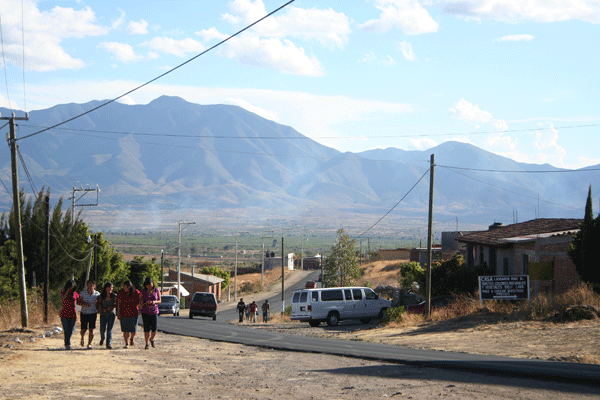
Perception vs. reality
Immigration and media reports have had an immeasurable impact on how those in the United States view Mexico. In March, the Trans-border Institute of the University of San Diego tallied more than 50,000 homicides in Mexico between 2006-2011.
Yet David Shirk, who teaches at the university, said the institute tries to keep things in perspective.
“There have been relatively few killings involving U.S. tourists,” he said. “Roughly a million U.S. citizens reside in Mexico. Yet only 120 U.S. citizens were among the 16,000 killed last year, and most of those were likely targeted for connections to organized crime.”
Mexico City and other large cities have good and bad parts, Martinez said, just like anywhere else. But in general, he said even the Mexican states that have seen the highest amount of drug-related violence are relatively safe.
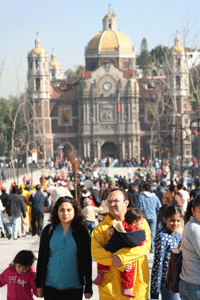
Martinez noted specifically the silver mining town of Taxsco, in the state of Guerrero, where thousands have been killed. He said he’s consistently brought tourists there without incident.
He also brings tourists to Mexico City, Oaxaca and Puebla where visitors delight in first-class museums and rich cultural expression. The beauty of the churches and chapels rivals that of Europe.
Through the pyramids, visitors come to see how faith and religion were a part of this land since its inception. Christianity replaced the Native gods, but faith and belief in the supernatural remain essential.
The Mexican government’s oppression of the Church in the 1920s seems somewhat absurd in light of the nation’s history. The Cristero War, or Cristiada, was waged against a government that persecuted Catholics from 1926-1929.
The government prohibited the celebration of Mass, so priests celebrated them in secret. The war was named after the rebels’ rallying call — ¡Viva Cristo Rey!, or “Long live Christ the King!”
John Paul II canonized a group of 25 martyrs from that time. Faith is so close to the heart of the Mexican people that they were willing to die for it.
This rich history, which can serve as an example to Catholics across the world, is on display throughout Mexico. The history, too, is part of every day life.
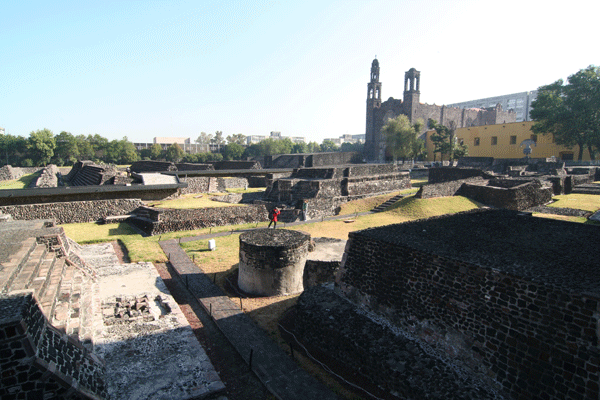
At the “Plaza de las Tres Culturas,” or the “Square of the Three Cultures,” tourists can see the Church of Santiago de Tlatelco, where it is said that San Juan Diego was baptized. The church was built in the 16th century from the remains of the Aztec ruins. The ruins lie before it while modern buildings sit behind it.
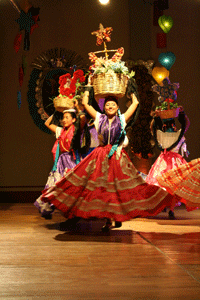
Being mestiza, Our Lady of Guadalupe also embodies these three cultures; she reflects the indigenous, the Spanish and the fruit that came from the union of the two. She facilitated this union.
Mexican artwork reflects this coming together as well. Tourists will see it in the murals of Diego Rivera and in the dances of the Ballet Folklorico. But nowhere will they see this union more than in the Mexican people themselves.
It’s as if the people, despite centuries of violence, are born with a disposition that’s open to foreigners. They’ve seen how messy it can get when two cultures collide, but, with God at the center of their lives, they’ve also seen the beauty that comes when two cultures become one.
¡Viva México! ¡Viva la Virgen de Guadalupe! ¡Viva Cristo Rey!
– – –
J.D. Long-García traveled to Mexico City, Puebla and Oaxaca with other Catholic journalists on a familiarization trip sponsored by Regina Tours and the Mexico Tourism Board. For more information, call 1-800-CATHOLIC or visit their website, www.1800Catholic.com.





